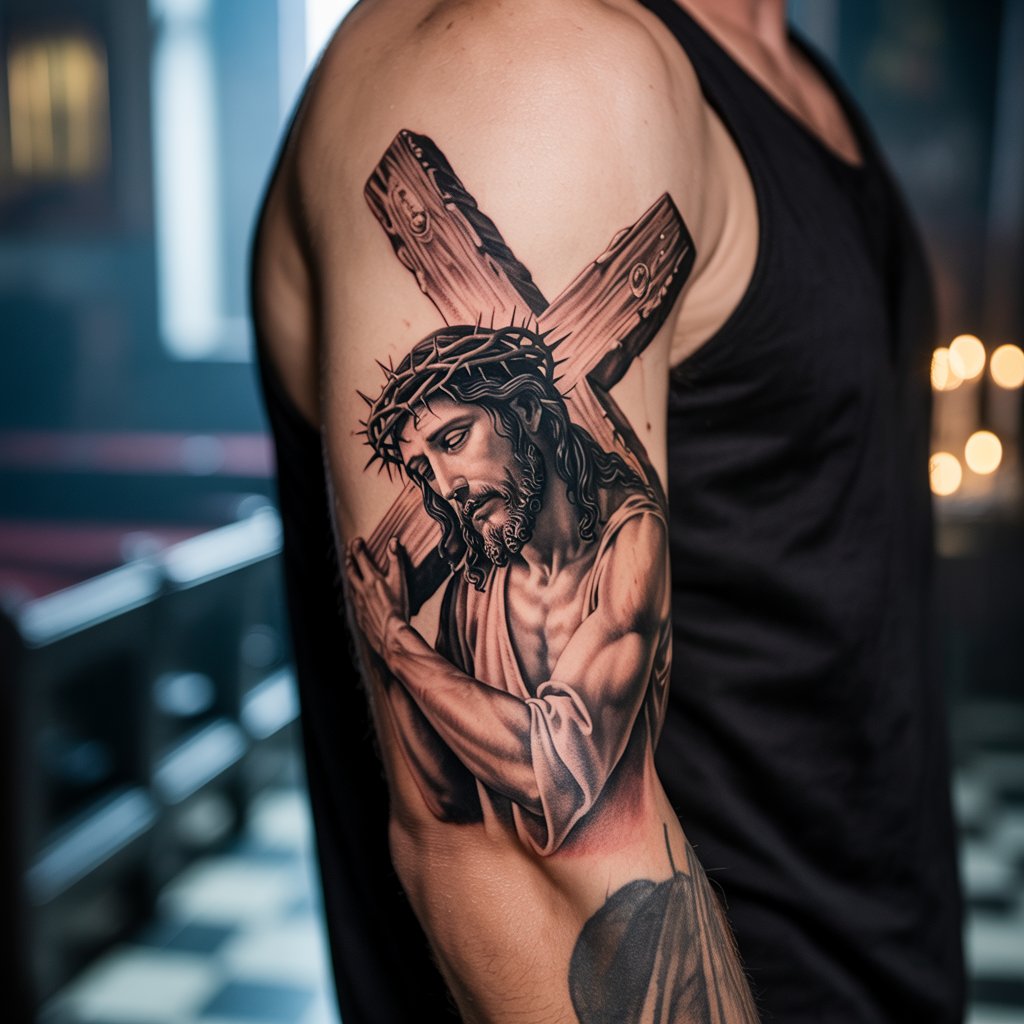In the realm of tattoo artistry, few subjects command as much reverence, technical mastery, and emotional depth as religious imagery. These sacred designs transform the human body into a living testament of faith, creating permanent reminders of spiritual devotion that accompany their bearers through every moment of their earthly journey. The profound religious tattoos showcased here demonstrate how master artists can capture the divine essence of sacred figures while honoring both artistic tradition and personal faith.
The Sacred Canvas: Understanding Religious Tattoo Placement
Religious tattoos carry a weight and significance that extends far beyond mere aesthetic appeal. The choice of placement becomes a spiritual decision, with each location on the body offering different symbolic meanings and practical considerations for the faithful individual seeking to honor their beliefs through permanent art.
The Spiritual Geography of the Body
Different body locations hold varying significance in religious tattoo tradition:
- Arms and Shoulders: Representing strength, protection, and the ability to carry spiritual burdens
- Back: The largest canvas for elaborate religious scenes and narratives
- Chest: Close to the heart, symbolizing deep personal faith and emotional connection
- Hands and Wrists: Visible reminders of faith that guide daily actions
- Legs and Calves: Symbols that travel with the believer on their spiritual journey
- Forearms: Easily visible designs that serve as conversation starters about faith
The masterful religious portraits shown in these images occupy prominent arm and shoulder placements, creating powerful statements of faith that are both personal and potentially shareable with others.
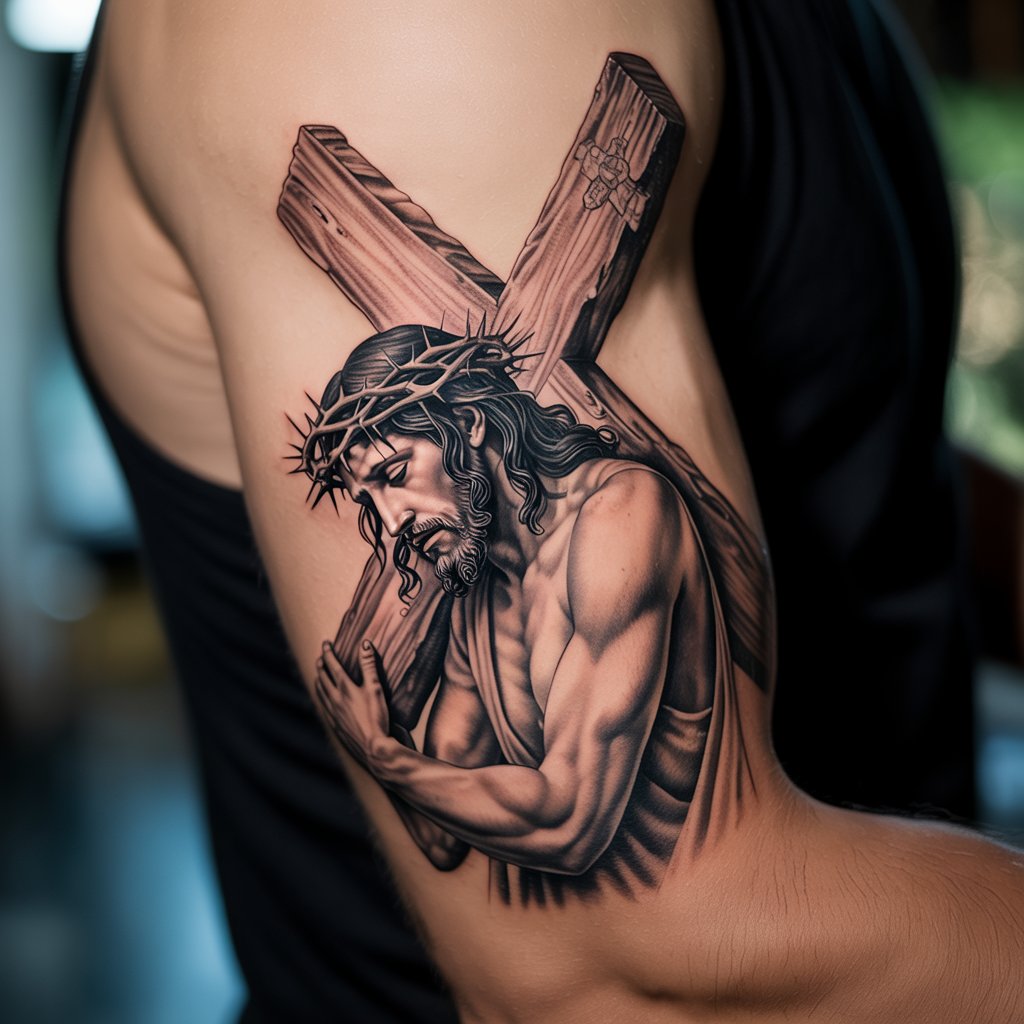
Cultural and Traditional Significance
Religious tattooing carries deep historical and cultural roots:
- Pilgrimage Traditions: Historical practice of marking religious journeys with permanent reminders
- Devotional Practices: Tattoos as forms of prayer and ongoing spiritual discipline
- Cultural Heritage: Connecting modern believers with centuries of religious artistic tradition
- Community Identity: Visible markers of shared faith and religious community membership
- Personal Testament: Individual declarations of belief that transcend words
- Protective Symbolism: Traditional belief in religious imagery as spiritual armor
This rich cultural foundation gives religious tattoos a depth of meaning that connects personal faith with broader spiritual traditions.
The Art of Sacred Portraiture: Capturing Divine Essence
The religious portraits featured in these exceptional tattoos demonstrate the highest levels of artistic skill in capturing not just physical likeness, but spiritual essence. These are not merely decorative images, but devotional art that seeks to embody the sacred nature of their subjects.
Technical Mastery in Religious Portrait Work
Creating compelling religious portraits requires extraordinary technical skill:
- Facial Expression Capture: Conveying the profound emotions of suffering, compassion, and divine love
- Anatomical Precision: Accurate rendering of human form while maintaining spiritual idealization
- Light and Shadow: Using contrast to create the luminous quality associated with divine subjects
- Fine Detail Work: Intricate rendering of features like hair texture, fabric folds, and skin tones
- Proportional Accuracy: Maintaining realistic proportions while achieving spiritual elevation
- Emotional Resonance: Technical skill serving the higher purpose of spiritual connection
The artists behind these works demonstrate mastery of realistic portraiture while serving the greater purpose of creating sacred art.
The Crown of Thorns: Symbolism and Artistic Interpretation
One of the most powerful elements in these religious tattoos is the crown of thorns, rendered with exceptional detail and symbolic weight:
- Suffering and Sacrifice: The thorns represent the pain endured for humanity’s salvation
- Divine Authority: The crown form acknowledging Christ’s kingship despite apparent defeat
- Human Cruelty and Divine Love: The contrast between humanity’s capacity for violence and divine forgiveness
- Artistic Challenge: The technical difficulty of rendering sharp thorns with realistic dimension
- Spiritual Meditation: Each thorn as a point of contemplation on suffering and redemption
- Visual Impact: The crown’s dramatic silhouette creating immediate recognition and emotional response
The masterful rendering of thorns in these tattoos demonstrates how technical artistry serves spiritual storytelling.
The Cross: Foundation of Faith and Artistic Composition
The wooden cross featured prominently in these designs serves both as religious symbol and artistic foundation, providing structural elements that organize and enhance the overall composition.
Symbolic Dimensions of the Cross
The cross carries multiple layers of religious and artistic meaning:
- Sacrifice and Redemption: The central event of Christian faith made visually present
- Intersection of Divine and Human: The meeting point of heaven and earth
- Victory Over Death: Symbol of triumph despite apparent defeat
- Universal Love: Arms extending to embrace all of humanity
- Structural Foundation: The cross as the organizing principle of the composition
- Historical Reality: The brutal instrument of execution transformed into symbol of hope
These tattoos capture both the harsh reality of crucifixion and its transformation into the ultimate symbol of love and sacrifice.
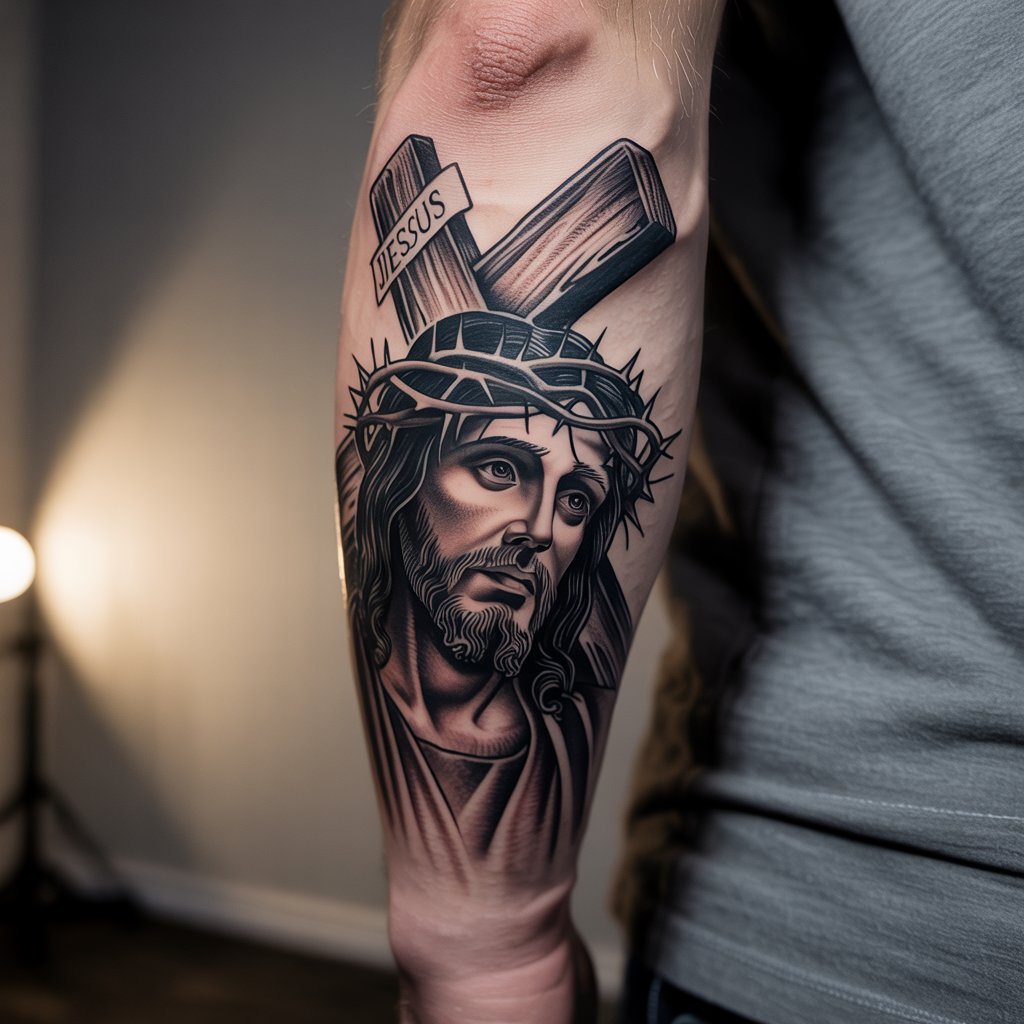
Wood Grain and Texture: Artistic Realism
The exceptional detail in rendering the wooden cross demonstrates advanced artistic techniques:
- Grain Patterns: Individual wood fibers and growth rings meticulously depicted
- Weathering Effects: Signs of age and exposure that add historical authenticity
- Dimensional Shading: Three-dimensional modeling that makes the wood appear tangible
- Surface Texture: Rough, splintered surfaces that emphasize the cross’s harsh reality
- Tool Marks: Evidence of human craftsmanship in the cross’s construction
- Natural Imperfections: Knots, cracks, and irregularities that enhance realism
This attention to material detail grounds the spiritual subject in physical reality, making the sacred more accessible and immediate.
The Sacred Figure: Artistic Interpretation of Divine Humanity
The central figures in these religious tattoos demonstrate exceptional skill in portraying the dual nature of divine and human characteristics, creating images that inspire both reverence and personal connection.
Facial Expression and Emotional Depth
The artistic rendering of sacred faces requires extraordinary sensitivity:
- Suffering and Serenity: Balancing pain with peace in facial expressions
- Divine Compassion: Eyes that convey infinite love and understanding
- Human Vulnerability: Acknowledging the physical reality of suffering
- Spiritual Strength: Inner power visible despite external weakness
- Timeless Quality: Features that transcend specific historical periods
- Personal Connection: Faces that invite individual contemplation and prayer
The artists have achieved portraits that function as both artistic masterpieces and devotional focal points.
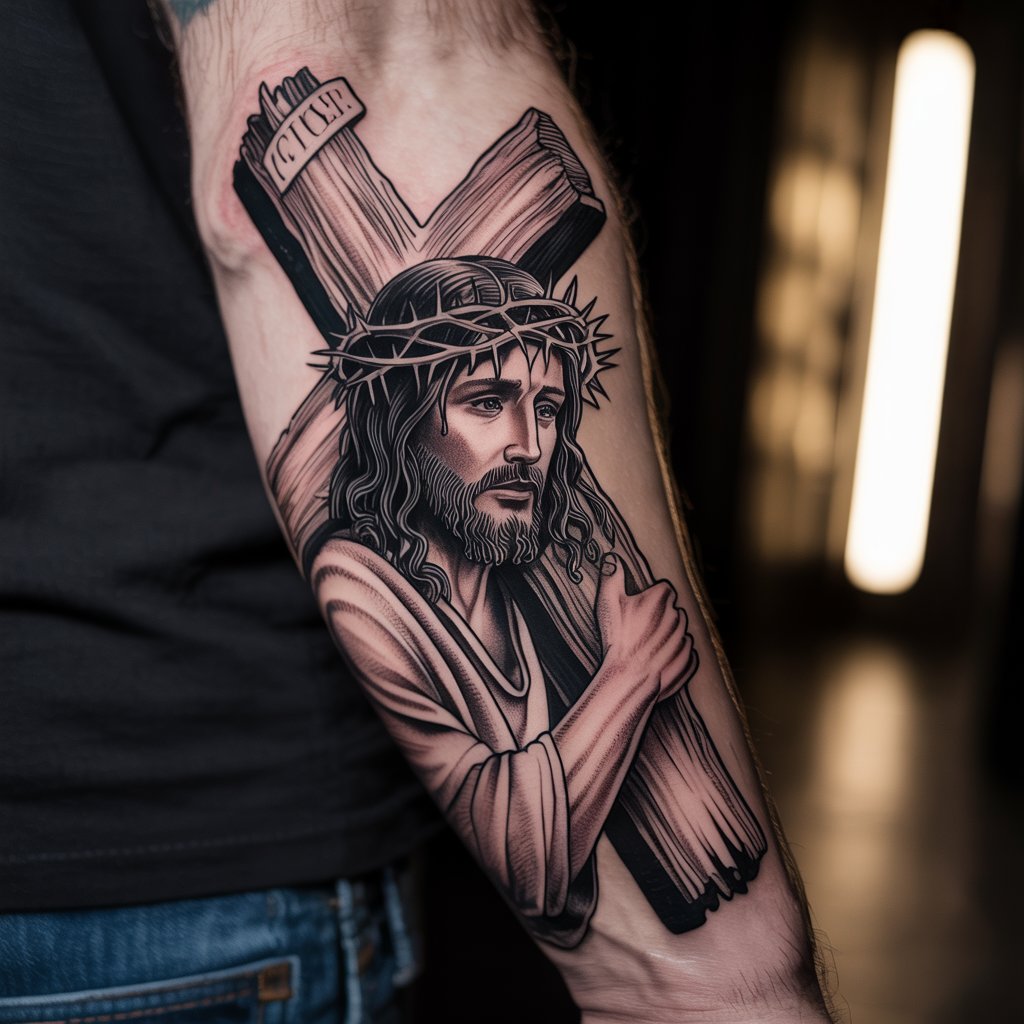
Hair and Beard: Symbolic and Artistic Significance
The detailed rendering of hair carries both artistic and symbolic importance:
- Cultural Authenticity: Hair styles reflecting historical and cultural context
- Textural Mastery: Individual strands and natural flow patterns
- Symbolic Length: Traditional associations of long hair with wisdom and spiritual power
- Light Interaction: How light plays through hair to create luminous effects
- Movement and Life: Hair that appears to move, adding vitality to static portraits
- Artistic Challenge: The technical difficulty of rendering realistic hair textures in tattoo medium
This attention to detail in hair rendering demonstrates the artist’s commitment to creating fully realized portraits.
Fabric and Drapery: The Art of Sacred Garments
The clothing depicted in these religious tattoos showcases advanced understanding of fabric behavior and symbolic meaning, adding layers of visual and spiritual richness to the compositions.
Technical Fabric Rendering
Creating realistic fabric in tattoo form requires sophisticated artistic skills:
- Fold Patterns: Understanding how different fabrics drape and fold naturally
- Weight and Movement: Conveying the physical properties of various textile types
- Light and Shadow: Using fabric folds to create dramatic lighting effects
- Texture Differentiation: Distinguishing between rough and smooth fabric surfaces
- Dimensional Modeling: Making flat tattoo surfaces appear three-dimensional
- Compositional Function: Using drapery to guide the viewer’s eye through the design
The masterful fabric rendering in these pieces adds to their overall realism and spiritual impact.
Symbolic Meaning of Sacred Garments
Religious clothing carries deep symbolic significance:
- Humility and Simplicity: Plain garments reflecting spiritual rather than material values
- Royal Purple: Traditional colors associated with divine kingship
- Priestly Vestments: Clothing that marks sacred roles and spiritual authority
- Cultural Context: Garments appropriate to historical and geographical settings
- Transformation Symbolism: Clothing that represents spiritual change and elevation
- Accessibility: Simple dress that makes divine figures approachable to common people
The clothing choices in these tattoos balance historical accuracy with symbolic meaning.
Composition and Visual Flow: Creating Sacred Narratives
These religious tattoos demonstrate sophisticated understanding of composition, creating visual narratives that guide the viewer through the spiritual story being told.
Hierarchical Composition
Religious art traditionally employs compositional techniques that emphasize spiritual importance:
- Central Focus: The sacred figure as the dominant visual element
- Supporting Elements: Cross and other symbols that enhance rather than compete
- Scale Relationships: Proportions that emphasize the importance of different elements
- Visual Weight: Distribution of dark and light areas to create balanced compositions
- Directional Flow: How the eye moves through the design in meaningful patterns
- Symbolic Placement: Positioning of elements according to their spiritual significance
These compositional choices serve the greater purpose of creating effective devotional art.
Integration with Body Anatomy
Successful religious tattoos work harmoniously with natural body contours:
- Muscle Definition: How tattoo elements interact with underlying anatomy
- Movement Accommodation: Designs that maintain integrity during normal body movement
- Natural Curves: Using body contours to enhance the three-dimensional quality of designs
- Proportion Scaling: Adjusting design elements to work with specific body proportions
- Anatomical Flow: Aligning tattoo elements with natural body lines and structures
- Practical Considerations: Ensuring designs work well with clothing and daily activities
The successful integration of these religious tattoos with body anatomy enhances their impact as living art.
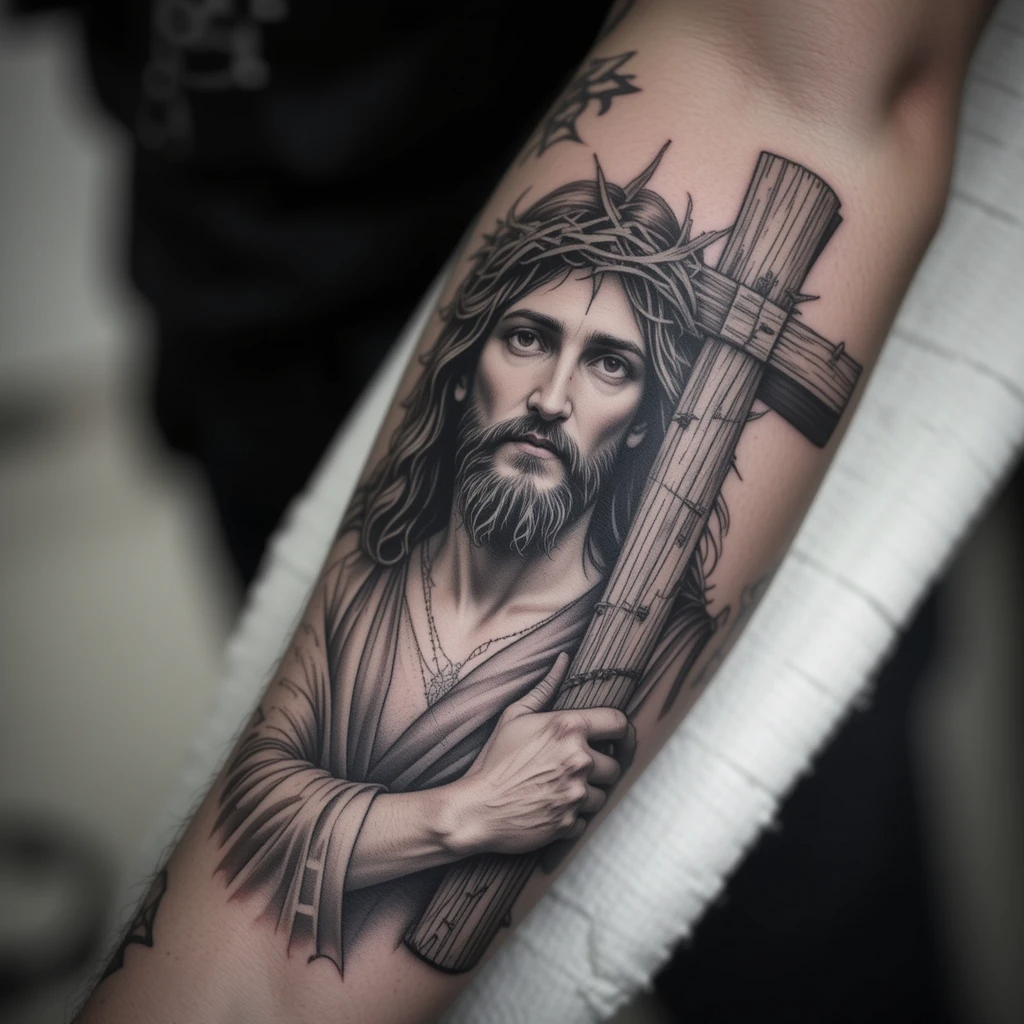
Color Theory and Symbolic Meaning in Religious Tattoos
While these particular examples showcase masterful black and gray work, understanding color symbolism in religious tattoos provides insight into artistic choices and spiritual meaning.
Traditional Religious Color Symbolism
Colors carry deep religious significance across traditions:
- Gold and Yellow: Divine light, glory, and heavenly presence
- Deep Blues: Heaven, truth, and divine wisdom
- Royal Purple: Majesty, nobility, and spiritual authority
- Crimson Red: Sacrifice, divine love, and martyrdom
- Pure White: Purity, innocence, and resurrection
- Earth Tones: Humanity, mortality, and connection to creation
The choice to work in black and gray allows these tattoos to focus on form, emotion, and spiritual essence rather than decorative color.
The Power of Monochromatic Religious Art
Black and gray religious tattoos offer unique advantages:
- Timeless Quality: Avoiding colors that might date the artwork
- Emotional Focus: Directing attention to expression and spiritual content
- Technical Emphasis: Highlighting the artist’s skill in shading and detail work
- Spiritual Contemplation: Creating meditative quality through restrained palette
- Universal Appeal: Working across different skin tones and cultural contexts
- Classical Tradition: Connecting with centuries of religious art in stone, wood, and metal
This monochromatic approach ensures these tattoos will remain powerful and relevant for decades to come.
The Spiritual Journey of Getting a Religious Tattoo
The process of receiving a religious tattoo involves more than artistic and technical considerations; it represents a spiritual journey that deepens the meaning of the final artwork.
Preparation and Contemplation
Getting a religious tattoo requires careful spiritual preparation:
- Prayer and Meditation: Seeking spiritual guidance about the decision
- Research and Study: Understanding the religious and artistic traditions being honored
- Artist Selection: Finding artists who respect and understand religious subject matter
- Design Development: Collaborative process of creating personally meaningful interpretations
- Community Consultation: Discussing intentions with religious advisors or community members
- Personal Readiness: Ensuring emotional and spiritual preparation for permanent commitment
This preparation process often becomes as spiritually significant as the tattoo itself.
The Sacred Nature of the Tattooing Process
Many believers find spiritual meaning in the tattooing experience itself:
- Enduring Discomfort: Connecting with traditions of religious discipline and sacrifice
- Meditation Opportunity: Using tattoo sessions as extended periods of spiritual contemplation
- Artist Collaboration: Working with skilled artists as a form of creative worship
- Community Witness: Sharing the experience with fellow believers or spiritual advisors
- Transformation Ritual: Marking important spiritual milestones or conversions
- Ongoing Prayer: Using tattoo sessions as opportunities for extended prayer and reflection
The tattooing process becomes a spiritual practice that adds meaning to the final artwork.
Caring for Sacred Art: Maintenance and Spiritual Responsibility
Religious tattoos require both physical care and spiritual stewardship, creating ongoing relationships between the believer and their sacred art.
Physical Maintenance as Spiritual Practice
Caring for religious tattoos can become a form of devotional practice:
- Daily Attention: Regular moisturizing and protection as acts of reverence
- Sun Protection: Preserving the artwork as stewardship of sacred images
- Professional Touch-ups: Maintaining the integrity of religious imagery
- Health Monitoring: Ensuring tattoos remain healthy as respect for the body as temple
- Seasonal Care: Adapting care routines to protect sacred artwork through all conditions
- Long-term Planning: Considering how aging will affect religious tattoos
This ongoing care creates continuous connection between the believer and their sacred art.
Living with Sacred Images
Religious tattoos create ongoing spiritual relationships:
- Daily Reminders: Sacred images that provide constant spiritual focal points
- Prayer Triggers: Tattoos that prompt regular prayer and meditation
- Conversation Starters: Opportunities to share faith with others
- Spiritual Accountability: Visible reminders of religious commitments and values
- Community Connection: Shared recognition among fellow believers
- Personal Transformation: How living with sacred art changes daily spiritual practice
These tattoos become integrated into the believer’s ongoing spiritual life and practice.
Religious Tattoos and Community: Faith Made Visible
Religious tattoos exist within broader communities of faith, creating connections and sometimes challenges that require thoughtful navigation.
Community Acceptance and Support
Religious communities vary in their acceptance of tattoo art:
- Traditional Perspectives: Understanding historical religious views on body modification
- Contemporary Acceptance: Growing recognition of tattoos as legitimate expressions of faith
- Generational Differences: Varying attitudes between older and younger community members
- Cultural Variations: Different cultural approaches to religious tattoos within faith communities
- Leadership Guidance: Seeking counsel from religious leaders about tattoo decisions
- Community Witness: Using tattoos as testimony and evangelistic opportunities
Successful integration of religious tattoos often requires ongoing dialogue within faith communities.
Evangelistic and Testimonial Opportunities
Religious tattoos can serve as powerful tools for sharing faith:
- Visual Testimony: Artwork that prompts questions about personal beliefs
- Conversation Starters: Natural opportunities to discuss religious faith with others
- Community Outreach: Using tattoos to connect with people who might not enter traditional religious spaces
- Youth Ministry: Connecting with younger generations through contemporary art forms
- Artistic Evangelism: Sharing faith through appreciation of beautiful religious art
- Personal Stories: Tattoos that provide opportunities to share conversion or faith experiences
These evangelistic opportunities add another layer of meaning to religious tattoo choices.
The Psychology of Sacred Ink: Faith, Identity, and Commitment
Religious tattoos involve complex psychological factors that intertwine personal identity, spiritual commitment, and artistic expression.
Identity Integration and Faith Expression
Religious tattoos become part of personal identity formation:
- Visual Faith Declaration: Making internal beliefs externally visible
- Identity Reinforcement: Constant reminders of religious identity and commitments
- Spiritual Confidence: How visible faith symbols affect personal spiritual confidence
- Social Identity: Connecting with communities of believers through shared symbols
- Personal Transformation: How religious tattoos mark and support spiritual growth
- Commitment Symbolism: Permanent artwork as expression of permanent faith commitment
This integration of faith and identity through tattoo art creates powerful psychological effects.
Spiritual Discipline and Accountability
Religious tattoos can function as tools for spiritual growth:
- Constant Reminders: Sacred images that prompt regular spiritual reflection
- Behavioral Influence: How visible religious symbols affect daily choices and actions
- Prayer Focal Points: Tattoos that serve as aids to meditation and prayer
- Spiritual Accountability: Visible commitments that encourage consistent spiritual practice
- Community Expectations: How religious tattoos create accountability within faith communities
- Personal Standards: Using sacred art as reminders of spiritual goals and values
These psychological effects transform religious tattoos into active tools for spiritual development.
Historical Context: Religious Tattoos Through the Ages
Understanding the historical context of religious tattoos enriches appreciation for contemporary sacred ink artistry.
Ancient and Medieval Traditions
Religious tattooing has ancient roots:
- Early Christian Marks: Historical evidence of early Christians marking themselves with religious symbols
- Pilgrimage Tattoos: Medieval traditions of marking religious journeys with permanent reminders
- Coptic Traditions: Egyptian Christian communities’ long history of religious tattooing
- Crusader Marks: Knights marking themselves with crosses and religious symbols
- Monastic Practices: Some religious orders incorporating body marking into spiritual discipline
- Cultural Integration: How different cultures adapted religious tattooing to local traditions
This historical foundation legitimizes contemporary religious tattoo practices.
Modern Revival and Artistic Evolution
Contemporary religious tattooing represents both continuation and innovation:
- Artistic Renaissance: Modern tattoo artists bringing fine art techniques to religious subjects
- Cultural Acceptance: Growing acceptance of tattoos in mainstream religious communities
- Technical Advancement: Modern equipment enabling unprecedented detail and realism
- Global Influence: Cross-cultural exchange enriching religious tattoo traditions
- Personal Expression: Individual interpretation of traditional religious themes
- Community Building: Modern religious tattoo communities sharing inspiration and support
This evolution demonstrates how ancient practices adapt to contemporary contexts while maintaining spiritual significance.
The Economics of Sacred Art: Investing in Religious Tattoos
Quality religious tattoos represent significant financial investments that require careful consideration and planning.
Understanding the Investment
Religious tattoos involve multiple cost factors:
- Artist Expertise: Specialized religious tattoo artists command premium prices
- Design Complexity: Detailed religious portraits require extensive session time
- Custom Artwork: Original religious designs involve additional design fees
- Session Requirements: Large religious pieces often require multiple sessions
- Geographic Variations: Location affects pricing for quality religious tattoo work
- Consultation Costs: Some artists charge for religious tattoo planning and design
Understanding these costs helps in budgeting for quality religious artwork.
Long-term Value and Spiritual Investment
Religious tattoos provide value beyond monetary considerations:
- Lifetime Significance: Permanent art that provides decades of spiritual value
- Community Connection: Investments in artwork that connects believers with their communities
- Artistic Legacy: Quality religious tattoos as contributions to tattoo art traditions
- Spiritual Tools: Functional art that serves ongoing spiritual development
- Personal Transformation: Investments in artwork that supports spiritual growth
- Cultural Contribution: Supporting artists who specialize in religious subject matter
Viewing religious tattoos as spiritual investments helps justify the significant costs involved.
Choosing the Right Artist: Finding Sacred Art Specialists
Creating exceptional religious tattoos requires artists with both technical skill and spiritual sensitivity.
Technical Requirements for Religious Tattoo Artists
Religious tattoo specialists must demonstrate:
- Portrait Mastery: Exceptional skill in realistic human face and figure rendering
- Fine Detail Capability: Ability to create intricate elements like thorns, fabric, and hair
- Composition Skills: Understanding of how to create balanced, meaningful religious compositions
- Cultural Knowledge: Familiarity with religious iconography and symbolic traditions
- Emotional Sensitivity: Ability to capture spiritual essence and emotional depth
- Professional Respect: Appropriate reverence for religious subject matter
These technical requirements ensure religious tattoos achieve both artistic excellence and spiritual authenticity.
Spiritual Sensitivity and Cultural Awareness
Beyond technical skill, religious tattoo artists need:
- Religious Understanding: Basic knowledge of religious traditions and meanings
- Cultural Respect: Sensitivity to different religious and cultural perspectives
- Collaborative Approach: Willingness to work with clients on personally meaningful interpretations
- Ethical Standards: Commitment to creating respectful and appropriate religious art
- Community Awareness: Understanding of how religious tattoos function within faith communities
- Ongoing Education: Commitment to learning about religious art traditions and meanings
This spiritual sensitivity ensures religious tattoos serve their intended devotional purposes.
The Future of Religious Tattoo Artistry
Religious tattoo art continues to evolve, incorporating new techniques and technologies while honoring ancient spiritual traditions.
Emerging Techniques and Technologies
New developments in religious tattoo artistry include:
- Enhanced Realism: Advanced techniques creating even more lifelike religious portraits
- Color Innovation: New pigments designed specifically for religious subject matter
- Digital Design: Software tools helping artists visualize complex religious compositions
- Collaborative Projects: Multiple artists working together on large religious pieces
- Cultural Integration: Blending religious traditions from different cultures in contemporary designs
- Healing Advances: Improved aftercare techniques ensuring better preservation of religious artwork
These innovations continue to expand possibilities for meaningful religious expression through tattoo art.
Growing Cultural Acceptance
Religious tattoos are gaining broader acceptance:
- Denominational Approval: More religious organizations accepting tattoos as legitimate faith expressions
- Academic Study: Scholarly research into religious tattoo traditions and meanings
- Artistic Recognition: Religious tattoos being featured in fine art exhibitions and publications
- Community Integration: Religious tattoo artists becoming recognized specialists within faith communities
- Interfaith Dialogue: Religious tattoos creating opportunities for interfaith conversation and understanding
- Youth Ministry: Religious organizations using tattoo art to connect with younger generations
This growing acceptance validates religious tattoos as legitimate forms of spiritual expression and artistic achievement.
Seasonal and Liturgical Considerations
Religious tattoos can be planned and revealed in coordination with religious calendars and seasonal spiritual practices.
Liturgical Timing and Meaning
Religious tattoo timing can enhance spiritual significance:
- Easter Season: Crucifixion and resurrection themed tattoos timed for maximum spiritual impact
- Advent Preparation: Using tattoo planning as part of spiritual preparation for religious holidays
- Lenten Discipline: Incorporating tattoo endurance into periods of religious sacrifice
- Baptism Coordination: Timing religious tattoos with baptism or confirmation ceremonies
- Pilgrimage Marking: Getting religious tattoos to commemorate religious journeys or pilgrimages
- Anniversary Commemoration: Marking spiritual anniversaries with meaningful religious artwork
This coordination between tattoo timing and religious calendar adds layers of spiritual meaning.
Seasonal Display and Concealment
Religious tattoos interact with seasonal clothing patterns:
- Summer Revelation: Warm weather providing opportunities to display religious artwork
- Winter Contemplation: Cold weather creating periods of private reflection with covered tattoos
- Holiday Significance: Religious tattoos having special meaning during religious holidays
- Worship Settings: Considerations about tattoo visibility in different religious contexts
- Community Events: How religious tattoos function at religious gatherings and celebrations
- Personal Seasons: Aligning tattoo revelation with personal spiritual seasons and growth
Understanding these seasonal dynamics helps maximize the spiritual impact of religious tattoo choices.
Medical and Health Considerations for Religious Tattoos
Religious tattoos require the same health considerations as all tattoo work, with additional factors related to their spiritual significance.
Health as Spiritual Stewardship
Caring for tattoo health becomes a religious responsibility:
- Body as Temple: Religious views of physical health as spiritual responsibility
- Infection Prevention: Protecting religious artwork through proper health practices
- Professional Care: Seeking qualified medical attention for tattoo-related health issues
- Lifestyle Integration: Adapting daily health routines to preserve religious tattoos
- Long-term Planning: Considering how aging and health changes will affect religious artwork
- Medical Consultation: Discussing religious tattoo plans with healthcare providers
This integration of health and spiritual considerations ensures religious tattoos remain beautiful and meaningful throughout life.
Healing as Spiritual Process
Tattoo healing can become part of spiritual practice:
- Patient Endurance: Using healing time for spiritual reflection and prayer
- Disciplined Care: Following aftercare instructions as spiritual discipline
- Community Support: Receiving help from faith community during healing process
- Meditation Opportunity: Using healing time for extended spiritual contemplation
- Gratitude Practice: Appreciating the healing process as divine gift
- Transformation Symbolism: Physical healing reflecting spiritual transformation
This spiritual approach to healing enhances the overall meaning of the religious tattoo experience.
Conclusion: Sacred Art for the Modern Soul
Religious tattoos represent one of the most profound forms of contemporary spiritual expression, combining ancient faith traditions with cutting-edge artistic techniques to create permanent reminders of divine love and spiritual commitment. The exceptional examples showcased in these images demonstrate how master tattoo artists can capture not just the physical appearance of sacred figures, but the spiritual essence that makes religious art truly transformative.
These tattoos invite us to consider the sacred nature of the human body as a canvas for spiritual expression, creating permanent connections between the believer and the divine that transcend temporary emotions or circumstances. They represent commitments not just to artistic beauty, but to ongoing spiritual growth, community connection, and public witness of faith.
For those called to express their faith through permanent religious artwork, these designs offer inspiration for creating sacred art that honors both individual spiritual journeys and the broader traditions of religious artistic expression. They remind us that true religious art serves not just aesthetic purposes, but spiritual ones, creating focal points for prayer, meditation, and ongoing spiritual development.
In the evolving landscape of religious expression, tattoos stand as powerful testimony to the human need to make invisible faith visible, to carry sacred reminders through daily life, and to transform the human body into a living sanctuary that honors the divine presence in all aspects of earthly existence. These masterful religious tattoos demonstrate that when faith meets artistry, the result is not just beautiful decoration, but sacred art that enriches both the individual soul and the broader community of believers who share in the ancient and continuing tradition of making faith visible through permanent, beautiful, and deeply meaningful artistic expression.

